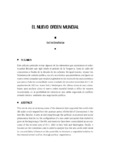Mostrar el registro sencillo del ítem
El nuevo orden mundial
| dc.creator | Correa Restrepo, Cruz Elvira; Universidad de Medellín | spa |
| dc.date.accessioned | 2016-01-29T23:02:39Z | |
| dc.date.available | 2016-01-29T23:02:39Z | |
| dc.date.created | 2004-06-30 | |
| dc.identifier.issn | 0120-6346 | |
| dc.identifier.uri | http://revistas.udem.edu.co/index.php/economico/article/view/1136 | |
| dc.identifier.uri | http://hdl.handle.net/11407/1920 | |
| dc.description | Este artículo pretende revisar algunos de los elementos que sustentaron el orden mundial (Bipolar) que rigió desde el período de la Posguerra, hasta la caída del comunismo a finales de la década de los ochenta. De igual manera, repasar los fenómenos de carácter político, social y económico que permitieron configurar un nuevo orden (Unipolar) que empezó a gestarse en los inicios de los años noventa y que parece haberse consolidado como resultado de los actos terroristas del 11 de septiembre de 2001 en Nueva York y Washington. Por último, toma el caso colombiano para analizar cómo el nuevo orden mundial tiende a influir de manera incontrolada, en la posibilidad de estructurar una salida negociada al conflicto armado interno, mediante una negociación política. | spa |
| dc.description.abstract | This article aims at reviewing some of the elements that supported the world order (Bi-polar) which reigned from the postwar period till the fall of Communism in the late 80s; likewise, it aims at skimming through the political, economical and social phenomena that led to the configuration of a new order (uni-polar) that started to grow at the beginning of the 90s and seems to have been consolidated as an outcome of the terrorist acts of 9/11, 2001 in New York and Washington. Finally, it focuses on the Colombian case in order to analyze how the new world order tends to uncontrollably influence on the possibility to structure a negotiated solution to the internal armed conflict, through political negotiations. | eng |
| dc.format.extent | p.43-62 | spa |
| dc.format.medium | Electrónico | spa |
| dc.format.mimetype | application/pdf | |
| dc.format.mimetype | ||
| dc.language.iso | spa | |
| dc.publisher | Universidad de Medellín | spa |
| dc.relation | http://revistas.udem.edu.co/index.php/economico/article/view/1136/1105 | spa |
| dc.relation.ispartofseries | Semestre Económico; Vol. 7, núm. 13 (2004) | spa |
| dc.relation.haspart | Semestre Económico; Vol. 7, núm. 13 - enero/junio 2004 | spa |
| dc.rights.uri | http://creativecommons.org/licenses/by-nc-sa/4.0/ | * |
| dc.source | Semestre Económico; Vol. 7, núm. 13 (2004); 44-62 | spa |
| dc.source | 2248-4345 | spa |
| dc.source | 0120-6346 | spa |
| dc.subject | World order | spa |
| dc.subject | war | spa |
| dc.subject | bipolar | spa |
| dc.subject | single-pole | spa |
| dc.subject | Orden mundial | spa |
| dc.subject | posguerra | spa |
| dc.subject | bipolar | spa |
| dc.subject | unipolar | spa |
| dc.title | El nuevo orden mundial | spa |
| dc.type | Articulo | eng |
| dc.type | Article | eng |
| dc.relation.citationvolume | 7 | |
| dc.relation.citationissue | 13 | |
| dc.relation.citationstartpage | 43 | |
| dc.relation.citationendpage | 62 | |
| dc.audience | Comunidad Universidad de Medellín | spa |
| dc.publisher.faculty | Facultad de Ciencias Económicas y Administrativas | spa |
| dc.coverage | Lat: 06 15 00 N degrees minutes Lat: 6.2500 decimal degreesLong: 075 36 00 W degrees minutes Long: -75.6000 decimal degrees | spa |
| dc.publisher.place | Medellín | spa |
| dc.relation.ispartofes | Semestre Económico | spa |
| dc.title.alternativees | The new world order | spa |
| dc.identifier.eissn | 2248-4345 | |
| dc.type.version | info:eu-repo/semantics/publishedVersion | |
| dc.type.driver | info:eu-repo/semantics/article |



